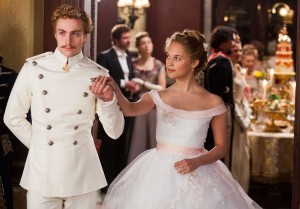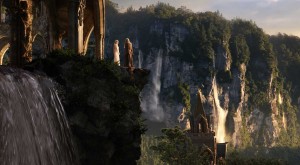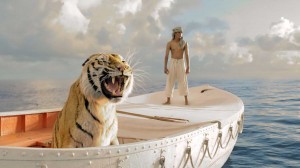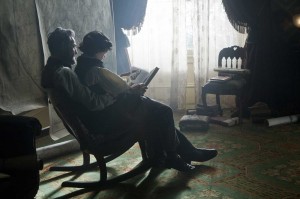
Production designer Sarah Greenwood and set decorator Katie Spencer are recognized for Joe Wright’s ambitious adaptation of Leo Tolstoy’s Anna Karenina. Greenwood and Spencer are longtime collaborators of the director’s, having worked on Atonement (2007) and Pride and Prejudice (2005), both also starring Kiera Knightley. They received Academy Award nominations for both films. They shared another nomination for director Guy Ritchie’s Sherlock Holmes (2009). Anna Karenina is a dramatic display of a theater coming to life. The film was originally set on location in Russia but Wright decided to tell the story against the backdrop of a crumbling, old theater.
This might seem to render the art direction a less complicated affair, but that would be far from the truth. The theater was built from scratch to accommodate all the set changes that would be created and frequently changed. Old art direction techniques were often employed. More than 50 backdrops were painted. The massive undertaking spanned over a period of 12 weeks, with the construction of 100 different sets to resurrect a lavish pre-Revolutionary Russia.

 In the first Hobbit film, Bilbo Baggins (Martin Freeman) and a company of dwarfs return to the kingdom Erebor, from which they have been exiled. Their travels lead them to many lands, including some which had adorned the screens for The Lord of the Rings film, and others that are being unveiled for the first time.
In the first Hobbit film, Bilbo Baggins (Martin Freeman) and a company of dwarfs return to the kingdom Erebor, from which they have been exiled. Their travels lead them to many lands, including some which had adorned the screens for The Lord of the Rings film, and others that are being unveiled for the first time.
The film was shot in 3D at 48 frames per second, instead of the usual 24, rendering exceptionably crisp and clear images. Meticulous attention to detail was paid to the scenery and digital animation. Hennah and his team held court at an eight-acre production facility in New Zealand to build the physical sets, which were blended with the virtual ones created at Weta Digital. Intricate subterranean tunnels, underground Goblin cities aglow with fire, shape-shifting mountainous terrain that comes to life, the production design in The Hobbit: An Unexpected Journey is an astonishing feat of imagination and skill.

Life of Pi takes place over three continents, two oceans and many decades, but centers around Pi – a zookeeper’s son in Pondicherry, India, who finds himself skip-wrecked and set adrift in a 26-foot lifeboat all alone except for the company of a 450-pound Bengal tiger named Richard Parker. The focus on the young man, the tiger and the deep blue sea is a wildly imaginative achievement, displaying images that pop with beauty and exuberance in the 3D film.
The scenes at sea were shot in the world’s largest self-generating wave tank (with a capacity of 1.7 million gallons) built by the crew in an abandoned airport in Taiwan. The ferocious tiger on board the lifeboat appears mostly through CGI.
The art department applied an earnest dedication to the details. Gropman took his inspiration for Pi’s lifeboat from archival drawings of 1940s steel lifeboats. Haan Lee (Ang Lee’s son) designed Pi’s makeshift raft, which the character builds to distance himself from the not so friendly tiger. The raft was build with materials that would have been found on a lifeboat: oars, life jackets, floorboard and life preserver rings. The raft itself ended up being an expression of Pi – a triangle with a circle for the center.

The film was shot in Richmond, Va. which held many of the visual characteristics of Washington D.C. during Lincoln’s time in the office. Many of the city’s buildings served as doubles. The state capitol building appeared as the White House from certain exterior angles. The building also became the setting to resurrect The White House portico. The legislative chamber became the U.S. House of Representatives. The White House interiors were build on sets in the city. The city streets were dressed to resemble the mess of a time of war.
The re-imagining of Lincoln’s environments was approached with a diligent sense of consciousness. As much detail as possible was attached to each setting. And much of Lincoln’s home-spun personality was injected into his surroundings to create an organic telling of the president’s story.

Inspired by the grave and beautiful story to be told in Les Misérables, Stewart threw herself into the research. She read the novel by Victor Hugo and traced the path the main character Valjean’s (Hugh Jackman) took from Toulon to Paris. She visited every museum and Mayor’s office along the way to find news clippings about the history of the 1832 revolution depicted in the story.
It was important to Stewart to always keep the story as the focus and her designs as a backdrop for the unfolding drama and not let the visual spectacle overshadow the story. The art department set to work painting everything by hand, carving enormous elephants and sculpting recreations of architecture. Les Misérables was a unique project where all the art departments and construction crew utilized their skills to recreate the world from historical drawings of the time period.
The work on the film is a celebration of great craft, which could be said for all the nominees this year.
Last year’s winner of the Academy Award for achievement in production design went to production designer Dante Ferretti and set decorator Francesca Lo Schiavo for director Martin Scorsese’s Hugo.
Try Below the Line’s Unofficial Awards Poll
[poll id=”29″]





